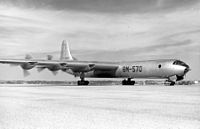Buzz Number
With Buzz number ( English to buzz : growl, roar) was a marking system of the US Air Force ( USAF designated (USAF)), which, with the help of oversized applied mark, in addition to a general identification of the aircraft in the air and to serve to convict pilots who carried out illegal low-level flights at high speed over populated areas (referred to in English as "buzzing"). Buzz Numbers were introduced after the end of World War II and were used until the early 1960s.
description
A buzz number was made up of three components: After a task abbreviation, which was assigned to an aircraft type depending on the intended use, there followed a sequential code letter for the type within the task area. A hyphen separated the two letters by a three-digit number, the last three digits of the USAF serial number . The complete serial number was also carried in a smaller version on the vertical stabilizer.
The first letter was based on the current designation system for military aircraft. Accordingly, in 1948 the code letter “P” for fighter planes was changed to “F” and at the same time the “F” for photo reconnaissance aircraft was changed to “R”. One of the last USAF designs with a buzz number was the F-110 , which was assigned the letter combination "FJ".
If there were other machines with the same type with the same three digits of the serial number, a distinctive letter was added at the end of the buzz number.
| image | example | Task abbreviation | Model | - | three-digit number |
- | optional |
|---|---|---|---|---|---|---|---|
 |
B-36 | - | 570 | ||||
 |
YF-12A | - | 936 | ||||
 |
F-84 | - | 424 | - | A. |
Web links
- All Buzz Numbers awarded (accessed December 1, 2017)
literature
- John M. Andrade: US Military Aircraft Designations and Serials since 1909 , Midland Counties Publ., 1979, ISBN 0-904597-22-9